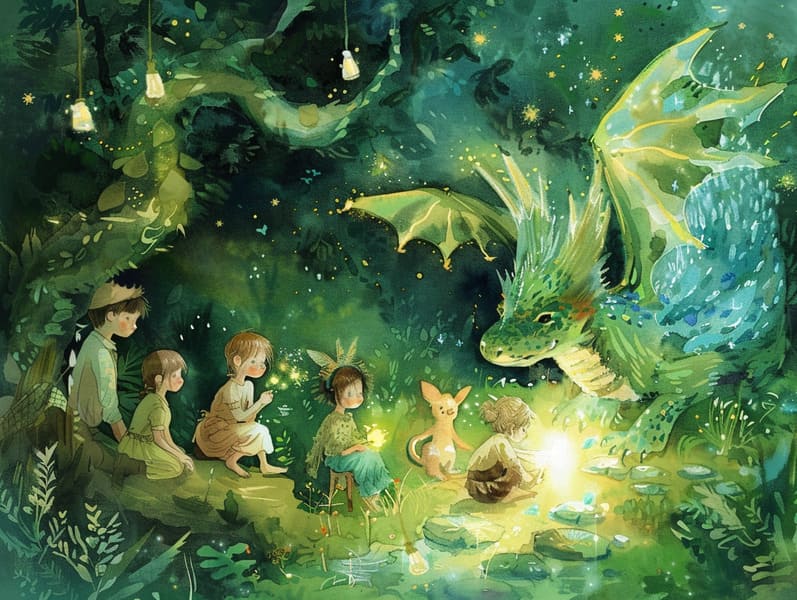
Legendary fairy tales have historical significance. These stories have been conveyed from one generation to the next centuries before they were ever inscribed. They were born from a variety of societies, including Eastern traditions. They were initially shared among older generations, often carrying themes and messages mirroring the societal norms and beliefs of the time.
The renowned Brothers Grimm, the two Grimm brothers, were among the first to compile and release many of these beloved fairy tales. Their anthology, "Grimm's Children's Stories," included tales like "Ashenputtel," "The Bread Crumb Trail," and "Schneewittchen," which have since become mainstays in the world of children's fairy tales. Similarly, Hans Andersen's imaginative stories, such as "The Little Mermaid," and "The Duckling's Story," have captivated hearts worldwide, cementing their place in the pantheon of famous fairy tales.
Despite being ancient, these stories remain as significant as ever, especially as kids' bedtime tales. These magical stories are now available in many formats, including artistically illustrated books, delightful animations, and digital fairy tales.
Their lasting presence can be linked to several captivating elements:
Vital Lessons: Ancient fairy tales often whisper important moral lessons. Stories like "The Story of the Boy Who Cried Wolf" teach the benefit of truthfulness, while "The Tale of the Tortoise and the Hare" point out the merits of perseverance and meekness. These tales offer kids clear distinctions between right and wrong, building their moral compass in a mild yet deep way.
Compassion and Knowledge: Fairy tales frequently include individuals facing trials and tribulations, urging listeners to empathize with their struggles and root for their triumphs. For instance, "Beauty and the Beast" teaches us the virtue of appreciating inner worth to see the inner self of a being, advancing sympathy and appreciation.
Cultural Recognition: Many ancient fairy tales are deeply embedded in the cultural contexts from which they originated. Reading these fairy tales can provide delightful insights into different traditions, strengthening a sense of cultural understanding and respect.
Creativity and Fantasy: The fantastical elements in classic fairy tales—mythical creatures—foster children’s dreams. These narratives transport readers to imaginary realms, engendering fantasy ideas and a sense of mystery that endures a lifetime.
Timeless fairy tales are not only fantastical but also didactic. They work as alluring tools in building various intellectual and emotional capacities in little ones. When classic fairy tales are told out loud, they boost speaking abilities by teaching new vocabulary and elaborate sentence structures. This practice also advances listening skills and attention, as young ones listen intently, eager to see what happens next.
Furthermore, deliberating the themes and characters of timeless fairy tales can advance intellectual skills and problem-solving abilities. Young readers are led to detect patterns, forecast, and make sense of cause and effect. These analyses also further the young voice their thoughts and feelings, nurturing their emotional intelligence.
In today’s electronic age, the presence of free fairy tales online has made these tales more accessible than ever. Digital sites and web apps supply large libraries of bedtime fairy tales that can be accessed or played anytime, anywhere. Fairy tales recited are particularly well-liked, extending an captivating way for children to delight in these whimsical stories. Narrated books and read-to-me stories transport characters and settings to life, often complemented by whimsical background sounds and music that amplify the story journey.
The persistent attraction of classic fairy tales lies in their ability to adjust to modern times while keeping their core messages. Contemporary reimaginings of these narratives often spotlight more multicultural protagonists and modern settings, making them understandable to today’s audience. However, the basic principles of guts, empathy, and equity remain unchanged, continuing to impact readers of all ages.
Ancient fairy tales also offer a sense of calm and comprehensibility. They distribute a tidy narrative with a straightforward beginning, middle, and end, often coming to a close with the finalization of conflicts and the triumph of righteousness over wickedness. This constancy can be calming for kids, proffering a sense of stability in an fluid world.
Timeless fairy tales continue to enthrall and guide new generations, maintaining their fascination and value in modern society. As kids' bedtime tales, they bequeath a perfect blend of charm and enlightenment, boosting moral values, empathy, and creativity. The presence of digital storybooks and the favor of fairy tales recited validate that these ancient fairy tales remain reachable to new generations.
By preserving and disseminating these fairy tales, we continue to cherish the rich tapestry of mythology and cultural heritage. Whether you are discovering a gorgeously illustrated book, experiencing a electronic collection, or listening through an spoken story, the loveliness of bedtime fairy tales is always within reach. These tales remind us of the unceasing strength of fairy tales and its ability to unify us across centuries and lands.
If you are reading a vibrantly illustrated book, discovering a web-based library, or listening on an voice book, the elegance of Grimm's fairy tales is always within reach.
These tales show us of the unending power of tales and its ability to bring us together across generations and cultures, forging a link that charms and informs find it here alike.
Comments on “The Emergence of Ancient Fairy Tales and the Immortal Enchantment.”